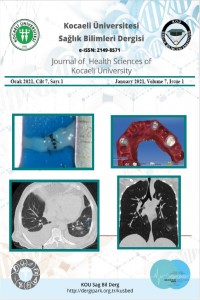Öz
Introduction: Traditional end-to-end microvascular anastomoses, the sine qua non of reconstructive microsurgery, has disadvantages, such as narrowing in the anastomosis line, excessive suture use, and risks of rotation and injuring the posterior wall especially for vessels with small diameter. It is aimed to compare the traditional method with a novel end-to-end vascular anastomosis technique suitable for use in very narrow vessels.
Methods: Fifteen female Wister Albino rats weighing 235-275 g were used. The experimental (Zigana) technique was applied to the right femoral artery, and the traditional anastomosis technique to the left. Operative time, suture counts, permeability rates and bleeding time were analyzed at clinical evaluation, and endothelialization, inflammation, fibrosis, foreign body reaction, intimal hyperplasia, intimal injury, thrombus and necrosis at histopathological evaluation.
Results: Clinical evaluation revealed a longer operative time, lower suture count, and a shorter bleeding time with the Zigana technique, while permeability rates were the same with both methods. Similar thrombus, stenosis, inflammation, fibrosis, and foreign body reaction rates were observed in both groups at histopathological examination. Intimal hyperplasia rates were lower in the Zigana technique group, while no necrosis was encountered in either.
Conclusion: The Zigana Technique exhibited better suture use and bleeding time values than the traditional method, although the difference between the two groups was not statistically significant. It is thought that the Zigana technique, which can yield positive results even with vessels less than 1 mm in diameter, is capable of use in microvascular anastomoses in both clinical and experimental studies.
Anahtar Kelimeler
Microvascular surgery reconstructive microsurgery end-to-end anastomoses
Kaynakça
- Buncke HJ Jr, Schulz WP. Total ear reimplantation in the rabbit utilising microminiature vascular anastomoses. Br J Plast Surg. 1966 Jan;19(1):15-22. doi: 10.1016/s0007-1226(66)80003-6.
- Rickard RF, Hudson DA. A history of vascular and microvascular surgery. Ann Plast Surg. 2014 Oct;73(4):465-472. doi:10.1097/SAP.0b013e31827 10027.
- Bschorer R, Frerich B, Wolburg H, Gehrke G, Schwenzer N. Fibrin sealing and histometrical changes in conventionally sutured microvascular anastomoses. J Craniomaxillofac Surg. 1993 Jul;21(5):192-198. doi: 10.1016/s1010-5182(05)80480-9.
- Siemionow M. Histopathology of microarterial anastomoses: end-to-end versus end-in-end (sleeve) technique. J Hand Surg Am. 1990 Jul;15(4):619-625. doi: 10.1016/s0363-5023(09)90025-9.
- Cobbett J. Small vessel anastomosis. A comparison of suture techniques. Br J Plast Surg. 1967 Jan;20(1):16-20. doi: 10.1016/s0007-1226(67)80003-1.
- Khouri RK. Avoiding free flap failure. Clin Plast Surg. 1992 Oct;19(4):773-81.
- Eisenhardt HJ, Hennecken H, Klein PJ, Pichlmaier H. Experiences with different techniques of microvascular anastomosis. J Microsurg. 1980 Mar-Apr;1(5):341-350. doi: 10.1002/micr.1920010503.
- O’Brien, B.M., Morrison, W.A., Reconstructive Surgery. Churchill-Livingstone. Edinburgh, Page 3-113,179-181,225, 1987
- Demiralp CO, Serel S, Zeyrek T, Demirseren ME, Ergun H, Yormuk E. New end-to-end microvascular anastomosis with geometrically adaptable ends technique: an experimental study on rats. Bratisl Lek Listy. 2011;112(9):483-487.
- Harashina T, Fujino T, Watanabe S. The intimal healing of microvascular anastomoses. Plast Reconstr Surg. 1976 Nov;58(5):608-613. doi: 10.1097/00006534-197611000-00012.
Öz
Amaç: Rekonstrüktif mikrocerrahinin olmazsa olmazı olan, geleneksel uç uca mikrovasküler anastomozların anastomoz hattında daralma, aşırı suture kullanımı ve damarda rotasyon ve özellikle küçük çaplı damarlarda arka duvar hasarı gibi dezavantajları mevcuttur. Bu sebeple küçük çaplı damarlarda kullanılabilecek yeni bir yöntemin geleneksel uç uca anastomoz tekniğiyle karşılaştırılması amaçlandı.
Yöntem: Bu çalışmada 15 Wistar Albino cinsi sıçan (235-275g) kullanıldı. Sağ femoral artere deneysel yöntem (Zigana), sol tarafa ise geleneksel yöntem uygulandı. Klinik değerlendirmede ameliyat süresi, dikiş sayıları, geçirgenlik oranları ve kanma zamanı; histopatolojik değerlendirmede endotelizasyon, inflamasyon, fibrosis, yabancı cisim reaksiyonu, intimal hiperplazi, intimal yaralanma, trombüs ve nekroz varlığı analiz edildi.
Bulgular: Klinik değerlendirmede, Zigana yöntemi ile daha uzun ameliyat süresi, daha düşük dikiş sayısı ve daha kısa kanama süresi ortaya çıkarken, geçirgenlik oranları her iki yöntemde de aynıydı. Histopatolojik incelemede her iki grupta da benzer trombüs, stenoz, inflamasyon, fibrosis ve yabancı cisim reaksiyon oranları gözlendi. Zigana yöntemi grubunda intimal hiperplazi oranları daha düşükken, hiçbir sıçanda nekroz izlenmedi.
Sonuç: Zigana yöntem`i, geleneksel yönteme göre daha az dikiş kullanımı ve daha kısa kanama zamanı değerleri sergilemiştir, ancak iki grup arasında istatistiksel anlamlı fark bulunmamaktadır. Çapı 1 mm`den daha küçük damarlarda bile olumlu sonuç verebilen Zigana yöntemi`nin hem klinik hem deneysel çalışmalarda kullanılabileceği düşünülmüştür.
Anahtar Kelimeler
Mikrovasküler cerrahi rekonstrüktif mikrocerrahi uç uca anastomoz
Kaynakça
- Buncke HJ Jr, Schulz WP. Total ear reimplantation in the rabbit utilising microminiature vascular anastomoses. Br J Plast Surg. 1966 Jan;19(1):15-22. doi: 10.1016/s0007-1226(66)80003-6.
- Rickard RF, Hudson DA. A history of vascular and microvascular surgery. Ann Plast Surg. 2014 Oct;73(4):465-472. doi:10.1097/SAP.0b013e31827 10027.
- Bschorer R, Frerich B, Wolburg H, Gehrke G, Schwenzer N. Fibrin sealing and histometrical changes in conventionally sutured microvascular anastomoses. J Craniomaxillofac Surg. 1993 Jul;21(5):192-198. doi: 10.1016/s1010-5182(05)80480-9.
- Siemionow M. Histopathology of microarterial anastomoses: end-to-end versus end-in-end (sleeve) technique. J Hand Surg Am. 1990 Jul;15(4):619-625. doi: 10.1016/s0363-5023(09)90025-9.
- Cobbett J. Small vessel anastomosis. A comparison of suture techniques. Br J Plast Surg. 1967 Jan;20(1):16-20. doi: 10.1016/s0007-1226(67)80003-1.
- Khouri RK. Avoiding free flap failure. Clin Plast Surg. 1992 Oct;19(4):773-81.
- Eisenhardt HJ, Hennecken H, Klein PJ, Pichlmaier H. Experiences with different techniques of microvascular anastomosis. J Microsurg. 1980 Mar-Apr;1(5):341-350. doi: 10.1002/micr.1920010503.
- O’Brien, B.M., Morrison, W.A., Reconstructive Surgery. Churchill-Livingstone. Edinburgh, Page 3-113,179-181,225, 1987
- Demiralp CO, Serel S, Zeyrek T, Demirseren ME, Ergun H, Yormuk E. New end-to-end microvascular anastomosis with geometrically adaptable ends technique: an experimental study on rats. Bratisl Lek Listy. 2011;112(9):483-487.
- Harashina T, Fujino T, Watanabe S. The intimal healing of microvascular anastomoses. Plast Reconstr Surg. 1976 Nov;58(5):608-613. doi: 10.1097/00006534-197611000-00012.
Ayrıntılar
| Birincil Dil | İngilizce |
|---|---|
| Konular | Cerrahi |
| Bölüm | Özgün Araştırma / Tıp Bilimleri |
| Yazarlar | |
| Yayımlanma Tarihi | 5 Ocak 2021 |
| Gönderilme Tarihi | 21 Şubat 2020 |
| Kabul Tarihi | 24 Kasım 2020 |
| Yayımlandığı Sayı | Yıl 2021 Cilt: 7 Sayı: 1 |


